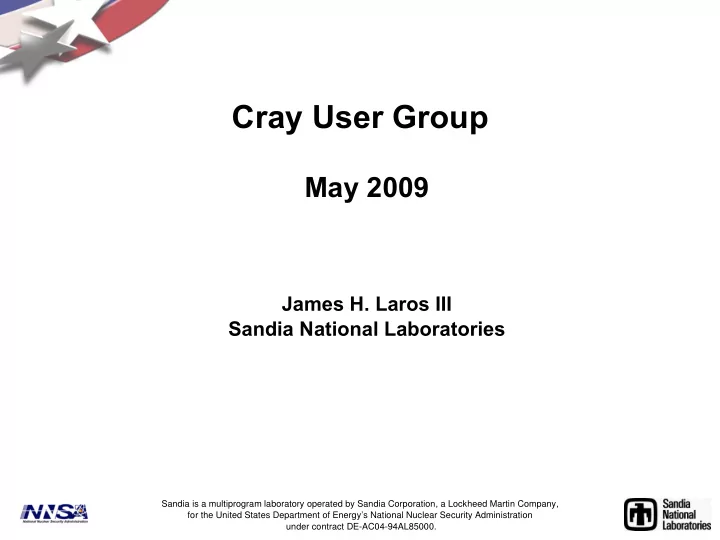

Cray User Group May 2009 James H. Laros III Sandia National Laboratories Sandia is a multiprogram laboratory operated by Sandia Corporation, a Lockheed Martin Company, for the United States Department of Energy’s National Nuclear Security Administration under contract DE-AC04-94AL85000.
Motivation • Average power consumption of a Top 9 system, 1.33 Mega-Watts (June 2008) st time power is reflected on the list – 1 • Average power consumption of a Top 9 system, 2.48 Mega-Watts (Nov 2008) • 54% Increase in 6 months! • Jaguar (ORNL) 6.95 Mega-Watts for 1.059 Peta-FLOPS – Projecting for 10 Peta-FLOPS 69.5 Mega-Watts – Seriously? • Clearly we will be considering 10's of Mega-Watts for multi Peta-FLOP class systems – What about Exe-FLOPS? – What about cost (delivery infrastructure etc)? – What about cooling (power in power out)
Power Collection Methods Past and Present • Measured by Meter – Cabinet level • Coarse collection • Extrapolate to larger system estimate – Component level • Single components measured • Again, extrapolate to larger system estimate • Performance Counters – Typically also used as basis for system level estimates • Should be verified – Can at an individual node scale but not at system scale
Real Power Collection • Not currently a feature of CRMS but we can leverage the existing infrastructure (H/W and S/W) • Additional daemon on each L0 (probing) – Registers a call-back in the main event loop – Uses event router to get information back up the hierarchy • Additional daemon on SMW (coalescence) – Collects the events and writes them out to flat file • Results – Granular collection (per-node - socket ) • Also Mezzanine (Seastar) but flat line current draw – High Frequency (1-100 samples per second) – Can collect current and voltage measurements – Scalable
CRMS Cray Reliability Availability and Serviceability Management System
XT4 Board
Real Power Collection (continued) (continued) • Output – Timestamped Hex values for current • and optionally voltage • Current in amps +/- 2amp accuracy • Post process output – Graphs (per node, per board) – Calculate application energy • More later – Ultimately, sum energy per job • Real time stats? • Better integration, output to DB...
Now that we have it what do we do with it? • Catamount Idle – We “thought” it was inefficient • Now we know it was • Linux employs power saving during idle cycles – Use for a benchmark to measure our success • Modified Catamount – Relatively straight forward (for OS code :) – Only two areas kernel enters during idle • Contrasted with CNL – Discovered our modifications are effective – Discovered Linux didn't act as we thought?
Initial CNL and Catamount IDLE Draw
Halt Individual Cores
Application Signatures • Noticed graphs of each application has its own, repeatable, recognizable shape – Even when run on different OS • Can we learn anything? – Can this be used for debugging? – Performance tuning? • We can calculate application energy – Amount of energy used over duration of application – Sure, find area under the curve • We now have “real” power used by applications – Use as an additional metric – Feed into power aware scheduling
Application Energy CNL Catamount
Application Energy • HPCC – 16% Faster on Catamount – 13% Less energy on Catamount • Obvious but important, longer run time = more energy used • Performance can have other benefits • How do other things that affect performance affect power use?
Closer examination 6 minute sample details emerge
Future Work • Quantify in dollars • Impact of OS noise on Power – We know OS noise can impact performance – What is the associated impact on power efficiency? • Does network imbalance impact Power? – Less bandwidth? – Higher latency? • Can we save power when running applications? – Go into lower power state while waiting... • Reduce frequency runs without affecting performance? – Little to no impact on run-time, large power savings?
Acknowledgments • Other Contributors – Kevin Pedretti – Sue Kelly – John Vandyke – Courtenay Vaughan – Mark Swan (Cray) • Local Administration Staff
Questions?
Recommend
More recommend